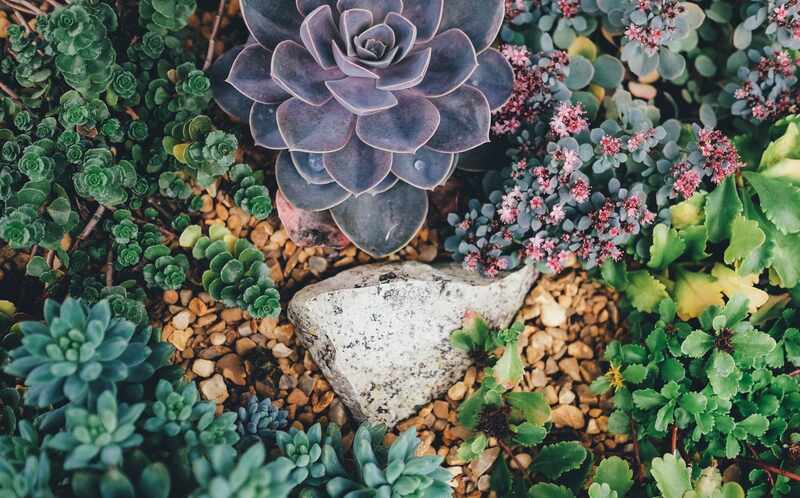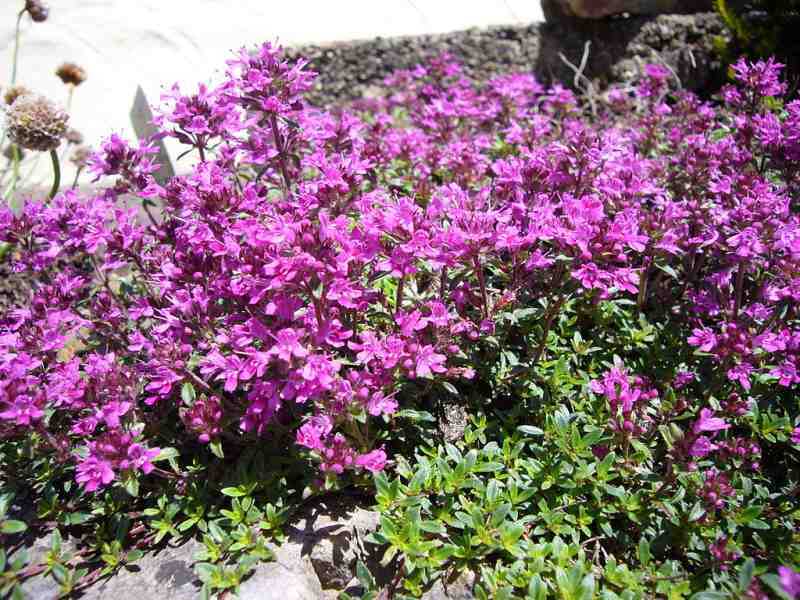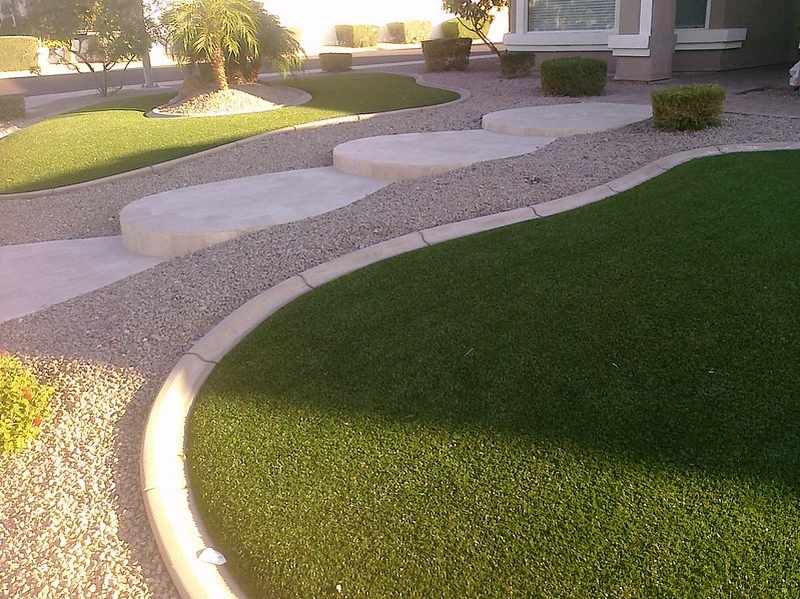Low-Maintenance Landscaping Tips for Phoenix, Arizona
BY AMANDA SHIFFLER | APRIL 17TH, 2023 | ARIZONA, LAWN CARE, PHOENIXWhen you live in Phoenix, you don’t want to spend weekends taking care of your lawn in the scorching Sonoran Desert. Yet at the same time, no one wants a patch of bare earth surrounding their house. You’re in the right place if you’re trying to find a balance between low-maintenance and curb appeal.
We’ve come up with a list of low-maintenance landscaping ideas to create a beautiful yard while reducing the time you spend outside maintaining it!
In this article:
1. Xeriscape Your Yard

Photo Credit: Simeon87 / Wikimedia Commons / CC BY-SA 3.0
Xeriscaping is a popular landscaping trend in Western desert climates, so chances are you’ve heard of the idea if you’ve lived in Phoenix for any length of time. But if you haven’t heard of it, it’s an adaptive landscape design that uses little or no water beyond natural rainfall.
Many homeowners love a xeriscape‘s environmental sustainability and its benefits. Here are some general ideas:
- Group plants with the same water requirements together in a process known as hydrozoning
- Use organic matter and mulch to retain soil moisture
- Steer away from turfgrass, or choose a drought-tolerant type
- Plant native, drought-resistant plants
- If necessary, use an efficient sprinkler system such as micro or drip irrigation coupled with a rain sensor
- Fill in open spaces with pavers, decorative rocks, or other hardscape elements
Don’t be discouraged if you can’t transform your entire landscape with xeriscaping in one fell swoop. Start small by replacing one flower bed with a decorative rock garden accented with succulents or replacing a thirsty non-native tree with a cactus. As you can, continue with the change until your entire yard doesn’t need supplemental water.
Advantages of xeriscaping:
- Saves time on watering your lawn and garden
- Reduces your water bill
- Conserves precious water resources
Estimated cost: It costs about $5 to $20 per square foot to xeriscape. However, it is estimated xeriscaping saves you about $0.36 per square foot yearly in watering costs.
2. Choose Desert-Friendly Succulents

Photo Credit: PxHere
Adding cacti and other succulent plants is a great way to make your landscaping low-maintenance. FYI: cacti are succulents, but not all succulents are cacti.
Succulents are plants that have adapted to desert life and low rainfall amounts by storing water in their stems and leaves. Many types have thick, fleshy leaves or engorged stems filled with sap that hold moisture, but not all do. One of the best parts (depending on how you look at it) is that most succulents hate wet soil and will die if you try to water them.
Plus, succulents come in a fantastic variety of shapes, sizes, and colors to fit every landscape design.
Advantages of succulents:
- Incredibly drought tolerant
- Thrive naturally in Arizona’s desert climate
- Thousands of varieties to choose from
Estimated cost: The price of succulents depends on the size and type of plant, ranging from $5 to more than $100 per plant at your local Lowe’s or Home Depot. Saguaro cacti can run anywhere from $100 to $4,000 or $5,000, depending on the size and number of arms.
3. Rely on Arizona’s Native Plants

Photo Credit: Matt Lavin / Flickr / CC BY-SA 2.0
Another great low-maintenance landscaping option is to include plants native to the Sonoran Desert in your landscape. Native plants have always been in an area and weren’t introduced from somewhere else. They have adapted to thrive in the local desert over time so that they can flourish in your yard with little care.
There are many Arizona native plants for you to choose from, but here are a few popular ones:
- Tufted evening primrose (Oenothera caespitosa)
- Firecracker penstemon (Penstemon eatonii)
- Desert fairy duster (Calliandra eriophylla)
- Desert willow (Chilopsis linearis)
- Desert ironwood (Olneya tesota)
Note: For more information on the best native plants for Phoenix, check out our article.
Advantages of native plants:
- Naturally adapted to thrive in Arizona’s climate
- Use less water than non-natives
- Require less fertilizer than non-natives
- Rarely have insect problems
- Provide shelter, nectar, and food for wildlife, including birds and pollinators
- Help to preserve local natural ecosystems
Estimated cost: How much you spend depends on the exact type and the plant size, but ballpark prices are $600 to $3,000 for a new flower bed, $25 to $50 per new shrub, or $150 to $3,000 per new tree.
4. Make Your Life Easier With Perennials

Photo Credit: USFWS Mountain-Prairie / Flickr / CC BY 2.0
Plants are designated as perennials or annuals, depending on their lifecycle. Annuals with beautiful, colorful flowers are commonly seen at big box stores and garden supply centers. But they only live for a single season and die after they flower, and temperatures drop in the winter.
Perennials, however, can withstand the cooler winter temperatures and bloom year after year. Since they last for several years, or even decades, they require considerably less maintenance than annuals that need replanting yearly.
Great heat-tolerant perennials for Phoenix:
- Blanket flower (Gaillardia grandiflora)
- Desert globemallow (Sphaeralcea ambigua)
- Desert marigold (Baileya multiradiata)
- Hyssop (Hyssopus officinalis)
- Perky sue (Tetraneuris acaulis)
- Blackfoot daisy (Melampodium leucanthum)
Advantages of perennials:
- Bloom yearly
- Some will last for decades without replacement
Estimated cost: The cost of perennial plants varies widely depending upon the type of plants you choose, where you purchase them, and if you plant them yourself or hire a landscape contractor to do the work. If you go the DIY route, expect to spend about $10 to $60 per plant.
5. Opt for Hardscapes Over High-Maintenance Softscapes

Photo Credit: Public Domain Pictures
A low-maintenance landscape with minimal flowers will reduce the time you spend sweating in the garden. However, a low-maintenance yard doesn’t mean a dull, empty space without any visual interest. You can easily create an oasis with hardscaping elements.
Hardscapes are features in your yard that aren’t green, living things. They are permanent, unchanging, man-made structures. The following offer limitless options for designing a space you’ll love while boosting curb appeal.
- Stone or concrete patios
- Decorative boulders
- Stone pavers
- Rock gardens
- Garden pathways
- Fire pits
- Custom built pergolas
- Composite material decks
The best part about hardscapes is they don’t require maintenance like turfgrass and plants. You don’t have to worry about mowing, fertilizing, watering, or weeding, thus cutting down on the time you spend caring for your landscape. However, the initial costs can be expensive, but you’ll save in the long run.
Advantages of hardscapes:
- Only need occasional cleaning
- Cut down water usage
- Many hardscapes increase home value
Estimated cost: Expect to spend approximately $2,500 to $6,000 for a new patio, $5,000 to $11,000 for a new composite deck, $250 to $3,000 for a new fire pit, or $2,000 to $9,000 for a new pergola. Stone paver projects cost about $10 to $30 per square foot to install, depending on the type of stone.
6. Switch to Ground Covers

Photo Credit: Own Herby talk thyme / Wikimedia Commons / CC BY-SA 3.0
I get it. Sometimes you want to look out the kitchen window and see a thick green carpet of grass. How about switching that traditional turf out for a low-maintenance ground cover? You’ll still get a look similar to a green lawn while saving yourself from mowing grass in the scorching sun.
Ground covers are a group of plants that usually only grow a few inches tall. Once planted, they spread quickly to fill in space and can create the look of a lawn.
These heat-loving, drought-tolerant ground covers are great for Phoenix.
- Carpet sedum (Sedum lineare)
- Creeping thyme (Thymus spp.)
- Blue catmint (Nepeta x faassenii)
- Amethyst in snow (Centaurea montana)
Remember that ground covers are still plants, so they may need irrigating and will benefit from occasional fertilization to keep them looking their best. They are still much less work than grass, though.
Advantages of ground covers:
- No mowing required
- Fewer weeds and pests than turfgrass
- Use less water than a traditional lawn
- Many ground covers thrive without fertilizer
Estimated cost: Replacing your turf with ground cover costs $3.50 to $12.50 per square foot, depending on the type of ground cover plant you choose. Expect to spend more if you need to remove your existing grass.
7. Install No-Maintenance Artificial Turf

Photo Credit: Nick Bastian / Flickr / CC BY-ND 2.0
If the idea of a living ground cover still sounds like too much work, yet you still want to see green, consider installing artificial turf. Don’t worry! Your yard won’t look like a football field! Artificial turf has made significant advances, and some styles are designed to look like specific grass types. With a bit of research, you can choose something that is hard to tell that it isn’t real grass!
Artificial turf is great in many ways, but let’s take a minute and talk about the downsides. First, artificial turf is expensive to install, and it can damage the soil underneath it, which may have adverse effects. However, some studies show the environmental impact is no more significant than those associated with traditional turfgrass.
Advantages of artificial turf:
- No maintenance besides occasional cleaning
- No pest or disease problems
- Cut down water usage
Estimated cost: Professional installation of artificial turf costs anywhere from $5.50 to $19 per square foot, depending on the type you choose and your yard’s shape.
8. Mulch Your Plant Beds

Photo Credit: PxHere
Most homeowners are familiar with mulch and use it in their landscapes. Mulch is a loose material spread on the ground to help retain soil moisture, keep weeds at bay, and protect the plant’s roots from temperature extremes. Using it in planting beds is an easy, inexpensive way to reduce maintenance needs.
When it comes to mulch, there are many different options, including some organic and some inorganic. Organic mulches offer a more traditional look, but products like woodchips and pine straw must be replaced as they break down over time. When they decompose, they do add nutrients to the soil, which is a benefit. Gravel and rubber nuggets are great inorganic options because they have a long lifespan.
Advantages of mulch:
- Reduces weeds in plant beds
- Retains soil moisture to cut down on irrigation needs
- Adds a finishing touch to your landscape
Estimated cost: The cost of mulch varies depending on the type. When buying by the bag, expect to pay $2 to $5 per 2-cubic-foot bag for wood mulch. Rubber mulch runs $7 to $10 per 0.8-cubic-foot bag. Landscape rock differs a lot more in price, ranging from $5 to $45 per 0.5-cubic-foot bag. (Pricing based on products at Lowe’s and Home Depot). You can buy it in bulk to save money if you need a lot of mulch.
Professional Help for Your Low-Maintenance Phoenix Landscape
Living in the Arizona desert doesn’t mean spending hours and hours taking care of grass or having a dusty, dry patch of dirt for a lawn. Many different low-maintenance landscaping options will give you a beautiful yard, even in Phoenix! Hopefully, this helps give you some great ideas on creating a space you love that doesn’t require all your free time.
But we also understand that even a few minutes outside in the hot summer sun can feel miserable. If you’d rather hire someone to do the work, check out the services our local lawn care pros offer in Phoenix and surrounding areas.
Main Photo Credit: Desert Botanical Garden / Simeon87 / Wikimedia Commons / CC BY-SA 3.0